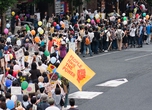Tokyo hunger strike
Naoya Okamoto: ‘Our generation's voice needs to be heard’

Tokyo hunger strikes: (L-R) Naoya Okamoto, Masaaki Yamamoto, Kanta Yonehara, Shiori Sekiguchi
Posted: Thu Sep 15 2011
Protesting is no longer an unusual sight in Tokyo, which might be why the small sit-in outside exit 12 of Kasumigaseki Station attracts scant enquiry. It's a common enough scene: a small gaggle of local university students, an array of brightly coloured, homemade placards, a guitar and... pouches of salt. It's the constant dabbing at salt that seems to draw attention, in fact. One protestor is dipping into it so frequently, he looks like a kid on a sherbet trip. What to make of this, I wonder? How to reconcile this image with the fact that what I'm witnessing is a hunger strike?
Think hunger strikes and, inevitably, you think Gandhi and Bobby Sands. Quite clearly, Naoya Okamoto (20) and his fellow strikers are in a less desperate situation, this being a kind of scheduled strike that will last only 10 days – enough to severely weaken the participants, but not bring them to death's door. Okamoto responds only vaguely when Sands' name is mentioned, pointing out that the hunger strike is such a rare form of protest here that few Japanese know much about it. 'The word doesn’t even exist in Japanese,' he says. 'The nearest might be danjiki [fasting], so “danjiki sutoraiki” [fasting strike] could work.'
'But it’s not like Ramadan,' his comrade, Shiori Sekiguchi (19), is quick to interject. 'We’re not eating anything for ten days, 24 hours per day.' Shiori, speaking a smattering of English, explains that they're allowing themselves only water and salt (which explains the dabbing), and that the strike will end on September 20. They’re currently into their fourth day. 'It's not too bad,' says Shiori, 'although standing up and sitting down is getting difficult.'
Naoya admits to feeling a little anaemic, but he's something of an old hand at this, having previously been involved in a 10-day hunger strike outside Yamaguchi Prefectural Hall. The protest is essentially the same, the continuation of a struggle well documented in Hiroko Tabuchi’s recent New York Times article, Japanese Island's Activists Resist Nuclear Industry’s Allure. The inhabitants of Iwaishima, Yamaguchi Prefecture, have been attempting to block plans for the development of a nuclear power station on their small island since 1982. Shiori says that they were relatively successful until two years ago, when the boats carrying building materials put out to sea again. 'They didn't have permission from the islanders, and they hadn't even done an environmental assessment of the area,' she says, exasperated. Naoya and his co-campaigners sat hungry outside the Prefectural Building, lending support to a campaign now in its 30th year, and to campaigners tiring as they enter old age.
Aside from drawing attention to the Iwaishima developments, the Tokyo hunger strike participants wish to make a wider appeal. As representatives of a generation that will have to bear the brunt of decisions made by Prime Minister Noda's new cabinet, their message is directed at both the government and people of their own age. 'For the young generation and generations to come, we see no bonus in having nuclear power plants,' explains Naoya. 'It's a poor legacy to be left with. We don't want to live with these plants, we don't want to live with the contamination they leave behind, and we don't want to live with the risks. For my part, I feel like our generation's voice needs to be heard, and it needs to be taken into account. I want everyone, especially people of my own age, to think about the cost of all this in terms of people's lives.'
The young striker may be knocking together a hardy CV of protests, but I'm struck by how uncomfortably he fits with the rallying stereotype. He looks considerably younger than his 20 years, and is dressed much like any other young Japanese guy might on a stifling late-summer's day. However, my colleague later points out that meeting Shiroto no Ran's Hajime Matsumoto, the leader of the group behind many of the anti-nuclear protests of the last six months, was similarly anti-climactic. These are not men chained to trees or holding out in fox holes beneath partially built runways. Although Matsumoto was jailed as a student for throwing paint at his university president, his more recent actions have been less flamboyant. His large-scale demos have been brought about by the influence he wields – leadership that has come through the respect that experience brings.
Talking to Naoya Okamoto, I get the sense that I could be meeting an embryonic Matsumoto, someone perhaps to watch in years to come. That said, I can't escape the nagging feeling that, by pre-scheduling the end of the hunger strike, he has removed the necessary do-or-die drama that would catch the headlines he hopes for. Not that I'd encourage anyone into that position; it's just that what is taking place outside Kasumigaseki Station feels brave but restrained. Maybe that's why the last six months of anti-nuclear protests have, at times, felt like little more than a sideshow.
Click here to follow the progress of the Tokyo hunger strike. The strikers also have a Facebook page, and Naoya Okamoto can be reached on his Twitter account, @HungryKinchan. You can visit the strikers in person outside exit 12, Kasumigaseki Station (Chiyoda, Hibiya lines)
Tokyo hunger strikers on Ustream live
Free desktop streaming application by Ustream
Tweets
- About Us |
- Work for Time Out |
- Send us info |
- Advertising |
- Mobile edition |
- Terms & Conditions |
- Privacy policy |
- Contact Us
Copyright © 2014 Time Out Tokyo














Add your comment